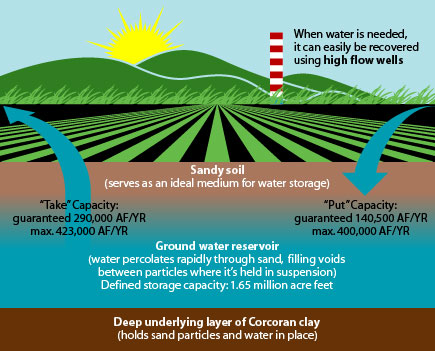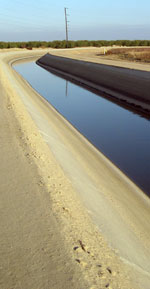|
|
|

What is groundwater banking?
- Groundwater
banking is a water management tool designed to increase water supply
reliability. By using dewatered aquifer space to store water during wet
years (years when there is abundant rainfall and surplus water
available), it can be pumped and used during dry years (years with
little rainfall and no surplus water).
- Groundwater banking
is accomplished two ways: through in-lieu and direct recharge. In-lieu
recharge
is storing water by utilizing surface water “in-lieu” of pumping
groundwater, thereby storing an equal amount in the groundwater basin. Direct
recharge is storing water by allowing it to percolate
directly to storage in the groundwater basin.
- At
Semitropic, wet year and surplus water is stored in the groundwater
basin primarily through in-lieu recharge. The district delivers surface
water to farmers for irrigation in-lieu (or instead of) pumping
groundwater.
- To
a lesser extent, Semitropic also stores water through direct recharge.
Throughout the district’s service area, there are a number of recharge
basins where water percolates to the groundwater basin.

- Whenever
necessary, the “banked” water is returned to the State Water Project to
deliver to banking partners by a release of Semitropic contract
entitlement or, in some cases, through “pumpback” to the California
Aqueduct at 300 cubic feet per second.
|
Cubic
feet per second (or cfs) refers to the standard term for the rate of
flow of irrigation water. A cubic foot per second of water is a cubic
foot of water (which is one foot wide, one foot long and one foot high)
passing a given point every second.
One cubic foot of
water is equal to approximately:
- 405 gallons
every minute.
- One acre-inch
every hour.
- One acre-foot
every 12 hours.
|
What safeguards does the district have in
place to ensure reliability of the groundwater storage bank?
- Accountability
is the foundation of the Semitropic Water Storage Bank. Storage and
recovery of water for each account is metered and closely monitored. A
report issued every time water is moved into or out of the bank helps
the district track the activities and levels of the storage bank.
- To further ensure the
reliability and accountability of the groundwater bank, a groundwater monitoring committee
was formed shortly after the groundwater storage bank was developed.
- Semitropic
believes in providing full disclosure to participating agencies and
makes every effort to provide adequate information to retain the trust
of its partners. Banking partners also have the option of auditing the
Semitropic Water Storage Bank at any time.
Is the water bank fully committed?
- No, there are still
approximately 450,000 acre-feet (or 150,000 shares) of storage
available.
How can agencies or organizations become
banking partners?
- Contact us
to find out more about the availability of storage capacity and
becoming a banking partner. A Semitropic Water Storage District
representative will send you additional information or schedule an
appointment for you to meet with district management.
What is the State Water Project?
- The California State Water Project
is a water storage and delivery system of reservoirs, aqueducts, power
plants and pumping plants. Its main purpose is to store water and
distribute it to 29 urban and agricultural water suppliers in northern
California, the San Francisco Bay Area, the San Joaquin Valley, the
central coast and southern California.
- The
project makes deliveries to two-thirds of California’s population and
is maintained and operated by the California Department of Water
Resources.
What is a 50 percent State Water Project
year?
- A
50 percent State Water Project (SWP) year means that only 50 percent of
the annual amount of water under contract with 29 water agencies with
long-term SWP contracts was available for allocation.
- Because
the SWP has not completed facilities to meet its contract obligation, a
reduction in allocations can result in water shortages at the local
level. As a local project, the Semitropic Water Storage Bank helps
increase water supply reliability in drought years to close the
shortfall in the state’s contract obligations.
|
|
 |

